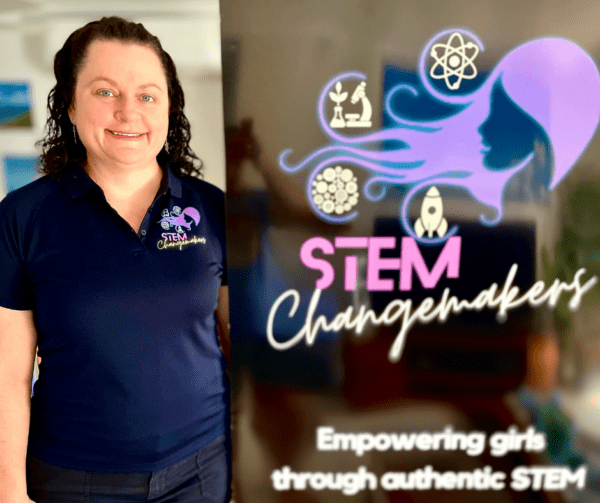In the heart of Walker Street sits a vibrant red bench nestled comfortably in front of the Townsville City Council building. Since its installation in 2021, this red bench has become one of many scattered throughout Townsville, acting as a powerful reminder of the prevalence of domestic violence in the community.
“The Red Bench Project, initiated by The Red Rose Foundation in 2016, aims to raise awareness of domestic violence and provide an opportunity for this important issue to remain visible in public,” explains Tracey McMenamin, General Manager of People and Culture at Townsville City Council.
“In 2021, Townsville City Council built upon this initiative, introducing red benches in every district including Magnetic Island, reminding us that domestic and family violence is more common than people realise.”
It is estimated that one in four Australian women and one in twenty Australian men experience domestic violence at some point in their lifetime. That means, statistically speaking, the likelihood of having an employee within your organisation or business who is experiencing domestic violence is alarmingly high.
Not only is this a sobering realisation but according to a report by PwC, domestic violence costs Australian businesses an estimated $1.9 billion every year due to absenteeism alone. This includes costs associated with sick leave, annual leave, and other forms of paid leave.
Whilst Australian paid leave entitlements for employees experiencing domestic and family violence will increase from five to 10 days in August 2023, Head of HR at Queensland Country Bank, Rebecca Campbell, says it is crucial that managers and employers have additional strategies in place to support those in vulnerable situations.
“Having support services available for employees experiencing domestic violence is not only a matter of doing what is morally right, but it can also save money in the long run by reducing absenteeism costs,” explains Rebecca.
“In addition to providing the 10 days of paid leave, Queensland Country Bank has implemented a range of policies and strategies to support staff in vulnerable situations.
“When it comes to victims of domestic violence, it is important to recognise that for some, work can be the only place left where they feel safe so many may not necessarily want to take the leave.
“Whilst we treat every situation on a case-bycase basis, we have standard policies in place that mean we can pay for an employee’s emergency accommodation if they require it, provide an early pay cheque if needed, and ensure there is security available when coming to and from work. We also have counselling available through our Employee Assistance Program.”
Navigating the complex landscape of legislation and determining the right measures to implement from a HR and policy level can be overwhelming for many businesses and organisations. However, Allan Ball, Director of White Ribbon Australia, says their Workplace Accreditation plays a key role in helping tackle this overwhelm.
The accreditation equips workplaces with essential strategies and provides an internal audit of policies, procedures, and workplace culture.
“It supports workplaces through a prevention and response model built around three key areas that look deeply at the drivers of prevention in workplaces with a focus on leadership, risk assessment, culture, support and prevention tactics,” says Allan.
“The program also gives companies a dedicated partner who is there to help them through a change process, as they fine-tune their policies, practices, and procedures to meet over 70 different actions that are evidence-based to promote respect at work.
“Workplaces shouldn’t have to do this work on their own. They need help to handle the complicated territory of respect at work practises, and our program shows them the way by giving them help and acting as a check and balance.”
Townsville City Council completed the White Ribbon Workplace Accreditation in 2021, which Tracey says marked an important step in their ongoing commitment to actively addressing domestic violence.
“Domestic Violence is a serious community issue and at Council we support and empower our own workforce through ensuring we have policies and procedures in place, alongside leave entitlements, EAP support and dedicated HR case managers who walk alongside our employees during these times to provide them confidential and caring support at all times,” continues Tracey.
“These initiatives assist us in playing our part in responding to and ending violence and ensuring our workplace prioritises safety, respect and equality for all individuals.
“After all, the goal is to one day no longer need to have any more red benches and other family initiatives, as we strive for a community free from domestic violence.”
In addition to the White Ribbon Accreditation, Tracey notes that there are several codes of practice, guidelines, and recommendations developed by government bodies and industry associations, such as Fair Work Australia, that provide support frameworks for employers.
These resources provide guidance on how to develop policies and procedures to respond to domestic violence, ways to provide appropriate support, and how to ensure privacy and confidentiality.
Yet, when it comes to considering legislation, Rebecca points out that it is important to consider ways you can extend support not only to employees, but also to customers, members and clients, that are often a core part of many businesses and organisations.
“As a member-owned bank, we have over 100,000 members that we get to know very well and cultivate this sense of trust among them,” continues Rebecca. “This trust allows us to genuinely understand their financial situations and be aware of any signs of behavioural or financial changes that could potentially be indicative of issues like domestic violence.
“We have a dedicated family and domestic violence page on our website where Members can reach out to someone within our organisation who will quickly connect them with the right people and ensure they can make decisions in vulnerable situations.
“At the end of the day, it all comes down to taking that first step and implementing policies that support employees in the workplace when they are in these vulnerable situations.
“It doesn’t matter the size of your business; what matters is that you have something in place to provide a safe and supportive environment for everyone.”
What can you do in your workplace?
- Develop a workplace policy that explicitly addresses domestic violence, outlining the organisation’s commitment to support affected employees.
- Ensure there are designated channels such as HR or contact persons through which employees can seek support discreetly.
- Conduct regular training sessions to educate employees about domestic violence, it’s signs and how to respond.
- Offer flexible work arrangements such as an adjusted scheduled, remote working options and time-off for appointments to accommodate their needs during this time.
- Provide access to Employee Assistance Programs or external counselling services that offer support.
Rebecca Campbell – Head of HR at Queensland Country Bank
Main image: Tracey McMenamin, General Manager of People and Culture at Townsville City Council.
Image credits: Georgie Desailly.
Click here to read the latest issue of BDmag.








